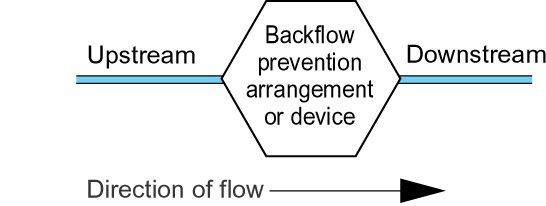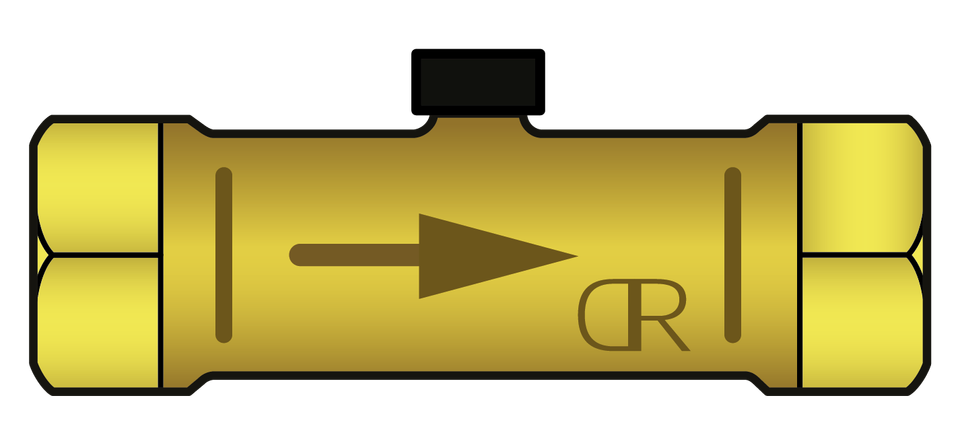
A backflow prevention arrangement or device is in effect a barrier intended to prevent contaminated fluid flowing backwards.
Backflow protection can be provided by an air or tap gap arrangement or a mechanical backflow prevention device approved be the Regulator (Regulators’ Specification), or alternatively authorised as a relaxation. (Relaxations allow a water undertaker the discretion to accept an arrangement as preventing backflow.)
The Regulators’ Specification not only provides definitions but also rates a backflow protection arrangement or device for suitability against contamination risk (fluid categories) and types of backflow risk - back siphonage or back pressure. They should always be accessible for inspection, maintenance and replacement.

Backflow prevention devices, are required to be corrosion resistant. For example, for metallic backflow prevention devices manufactured of gunmetal or other dezincification resistant materials. Dezincification water fittings are typically marked with a CR symbol.
As some backflow prevention arrangements and devices have operational limitations you should always check with the local water undertaker to make sure they are suitable for the intended application. Wherever practicable plumbing systems should be protected against backflow without the necessity to rely on mechanical backflow protection devices.
Please note: if high risk contaminants are likely to be present in a plumbing system, because these represent a greater risk to health, in addition to any point of use protection the water undertaker can also require the installation of zone or wholesite backflow protection.
Regulators Specification: Non-mechanical backflow protection | |||
Type | Description | Suitability by fluid category | |
Back pressure | Back siphonage | ||
Air gap with unrestricted discharge above spillover level | 5 | 5 | |
Air gap with weir overflow | 5 | 5 | |
Air gap with vented submerged inlet | 3 | 3 | |
Air gap with injector | 5 | 5 | |
Air gap with circular overflow | 4 | 4 | |
Air gap with minimum size circular overflow determined by measure or vacuum test | 3 | 3 | |
Air gap with interposed cistern | 3 | 5 | |
Air gaps for taps and combination fittings (tap gaps) discharging over domestic sanitary appliances, such as a washbasin, bidet, bath or shower tray shall not be less than the following: Size of tap or combination fitting . Not exceeding G ½ Exceeding G½ but not exceeding G ¾ Exceeding G ¾
Vertical distance bottom of tap outlet above spillover level of recieving appliance 20 mm 25 mm 70 mm
| X | 3 | |
Air gaps for taps or combination fittings (tap gaps) discharging over any higher risk domestic sanitary appliances where a fluid category 4 or 5 is present, such as:
Shall be not less than 20 mm or twice the diameter of the inlet pipe to the fitting, whichever is the greater | X | 5 | |
Pipe interrupter with permanent atmospheric vent | X | 5 | |
Notes:
| |||
Regulators Specification: Mechanical backflow protection | |||
Type | Description | Suitability by fluid category | |
Back pressure | Back siphonage | ||
Verifiable backflow preventer with reduced pressure zone | 4 | 4 | |
Non-verifiable disconnector with difference between pressure zones not greater than 10% | 3 | 3 | |
DA | Anti-vacuum valve (or vacuum breaker) | X | 3 |
Pipe interrupter with atmospheric vent and moving element | X | 4 | |
DUK1 | Anti-vacuum valve combined with a single check valve | 2 | 3 |
Verifiable single check valve | 2 | 2 | |
Non-verifiable single check valve | 2 | 2 | |
Verifiable double check valve | 3 | 3 | |
Non-verifiable double check valve | 3 | 3 | |
HA | Hose union backflow preventer. Only permitted for use on existing hose union taps in house installations | 2 | 3 |
HC | Divertor with automatic return (normally integral with some domestic appliance applications). | X | 3 |
HUK1 | Hose union tap which incorporates a double check valve. Only permitted for replacement of existing hose union taps in house installations | 3 | 3 |
LA | Pressurised air inlet valve | X | 2 |
LB | Pressurised air inlet valve combined with a check valve downstream | 2 | 3 |
Notes:
| |||
Regulations & Byelaws which apply include but are not limited to:
Relevant guidance includes but is not limited to:
We use cookies to give you the best possible experience with Water Regs UK. Some are essential to provide website functions and ensure the website is secure. We also use cookies to help us understand how people use the site and to make improvements. Click "Accept All" to enable recommended settings or click "Manage cookies" to adjust your settings. For more details, see our Cookie Policy.